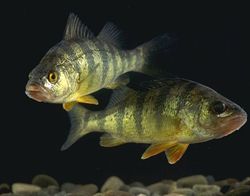|
Perciformes |

Yellow perch (Perca flavescens)
|
|
Scientific classification |
|
|
|
Families |
|
many, see text |
The Perciformes, also called the Percomorphi
or Acanthopteri, include about 40% of all
fish and are the largest order of
vertebrates. The name Perciformes means
perch-like. They belong to the
ray-finned fish and comprise over 7000 different
species, with varying shapes and sizes, found in almost all
aquatic environments. They first appeared and diversified in
the Late
Cretaceous.
Perciform fish typically have dorsal and anal fins
divided into anterior spiny and posterior soft-rayed
portions, which may be partially or completely separated.
There are usually pelvic fins with one spine and up to five
soft rays, either positioned by the throat or under the
belly. Scales are usually ctenoid in form, though sometimes
they are cycloid or otherwise modified. Various other, more
technical characters define the group.
Classification is controversial. As traditionally defined
the Perciformes are almost certainly paraphyletic. Other
orders that should possibly be included as suborders are the
Scorpaeniformes, Tetraodontiformes, and Pleuronectiformes. Of the presently recognized suborders
several may be paraphyletic as well.
Families
These are grouped by suborder/superfamily, generally
following
Fishes of the World.
- Suborder
Percoidei
- Superfamily
Percoidea
- Acropomatidae (temperate ocean-basses)
Ambassidae (Asiatic glassfishes)
Apogonidae (cardinalfishes)
Arripidae (Australasian salmon)
Banjosidae
Bathyclupeidae
Bramidae (pomfrets)
Callanthiidae
Carangidae (jacks, pompanos)
Caristiidae (manefishes)
Centracanthidae
Centrarchidae (freshwater sunfishes)
Centropomidae (snooks)
Chaetodontidae (butterflyfishes)
Coryphaenidae (dolphinfishes)
Dichistiidae (galjoen fishes)
Dinolestidae (long-finned pike)
Dinopercidae
Drepaneidae
Echeneidae (remoras)
Emmelichthyidae (rovers)
Enoplosidae (oldwife)
Epigonidae (deepwater cardinalfishes)
Gerreidae (mojarras)
Glaucosomatidae (pearl perches)
Grammatidae (basslets)
Haemulidae (grunts)
Inermiidae (bonnetmouths)
Kuhliidae (flagtails or aholeholes)
Kyphosidae (sea chubs)
Lactariidae (false trevallies)
Leiognathidae (ponyfishes)
Leptobramidae (beachsalmon)
Lethrinidae
Lobotidae (tripletails)
Lutjanidae (snappers, fusiliers)
Malacanthidae (Tilefishes)
Menidae (moonfish)
Monodactylidae (moonyfishes)
Moronidae (temperate basses)
Mullidae (goatfishes)
Nandidae (leaffishes)
Nematistiidae (roosterfish)
Nemipteridae (threadfin breams)
Notograptidae
Opistognathidae (jawfishes)
Oplegnathidae (knifejaws)
Ostracoberycidae
Pempheridae (sweepers)
Pentacerotidae (armorheads)
Percichthyidae (Temperate perches)
Percidae (perches and darters)
Plesiopidae
Polycentridae
Polynemidae (threadfins)
Polyprionidae (wreckfishes)
Pomacanthidae (angelfishes)
Pomatomidae (bluefishes)
Priacanthidae (bigeyes, catalufas)
Pseudochromidae (dottybacks)
Rachycentridae (cobia)
Sciaenidae (drums)
Scombropidae (gnomefish)
Serranidae (sea basses, groupers)
Sillaginidae (whitings et al)
Sparidae (porgies)
Terapontidae (grunters or tigerperches)
Toxotidae (archerfishes)
- Superfamily
Cirrhitoidea
- Aplodactylidae (marblefishes)
Cheilodactylidae (morwongs)
Chironemidae (kelpfishes)
Cirrhitidae (hawkfishes)
Latridae (trumpeters)
- Superfamily
Cepoloidea
- Suborder
Elassomatoidei
-
Elassomatidae (pygmy sunfishes)
- Suborder
Labroidei
- Cichlidae (cichlids)
Embiotocidae (surfperches)
Labridae (wrasses)
Odacidae
Pomacentridae (damselfishes)
Scaridae (parrotfishes)
- Suborder
Zoarcoidei
- Anarhichadidae
Bathymasteridae (ronquils)
Cryptacanthodidae
Pholidae
Ptilichthyidae
Scytalinidae
Stichaeidae (pricklebacks)
Zaproridae (prowfish)
Zoarcidae (eelpouts)
- Suborder
Notothenioidei
- Bathydraconidae
Bovichthyidae
Channichthyidae (crocodile icefishes)
Harpagiferidae (plunderfishes)
Nototheniidae
- Suborder
Trachinoidei
- Ammodytidae (sand lances)
Champsodontidae
Cheimarrhichthyidae
Chiasmodontidae
Creediidae (sandburrowers)
Leptoscopidae
Percophidae (duckbills)
Pholidichthyidae (convict blenny)
Pinguipedidae (sandperches)
Trachinidae (weeverfishes)
Trichodontidae (sandfishes)
Trichonotidae (sanddivers)
Uranoscopidae (stargazers)
- Suborder
Blennioidei
- Blenniidae
Chaenopsidae
Clinidae
Dactyloscopidae
Labrisomidae
Tripterygiidae
- Suborder
Icosteoidei
- Suborder
Gobiesocoidei
-
Gobiesocidae (clingfishes)
- Suborder
Callionymoidei
-
Callionymidae (dragonets)
-
Draconettidae
- Suborder
Gobioidei
- Eleotridae (sleepers)
Gobiidae (gobies)
Kraemeriidae (sandfishes or sand gobies)
Microdesmidae (wormfishes)
Odontobutidae
Ptereleotridae (dartfishes)
Rhyacichthyidae (loach gobies)
Schindleriidae
Xenisthmidae
- Suborder
Kurtoidei
- Suborder
Acanthuroidei
- Acanthuridae (surgeonfishes)
Ephippidae (spadefishes)
Luvaridae (louvar)
Scatophagidae (scats)
Siganidae (rabbitfishes)
Zanclidae (moorish idol)
- Suborder
Scombrolabracoidei
- Suborder
Scombroidei
- Sphyraenidae (barracudas)
Gempylidae (snake mackerels)
Trichiuridae (cutlassfishes)
Scombridae (mackerels and tunas)
Xiphiidae (billfishes)
- Suborder
Stromateoidei
- Amarsipidae
Ariommatidae
Centrolophidae (medusafishes)
Nomeidae (driftfishes)
Tetragonuridae (squaretails)
Stromateidae (butterfishes)
- Suborder
Anabantoidei
- Anabantidae (climbing gouramies)
Belontiidae (gouramies)
Helostomatidae (kissing gourami)
Luciocephalidae (pikehead)
Osphronemidae (giant gouramies)
- Suborder
Channoidei
References
-
"Perciformes".
FishBase. Ed. Ranier Froese and Daniel Pauly.
October 2004 version. N.p.: FishBase, 2004.
-
Perciformes (TSN 167640).
Integrated Taxonomic Information System. Accessed on 5
December 2004.
-
J. S. Nelson,
Fishes of the World (3rd ed.)




